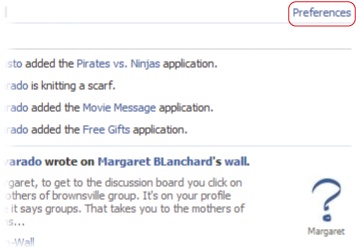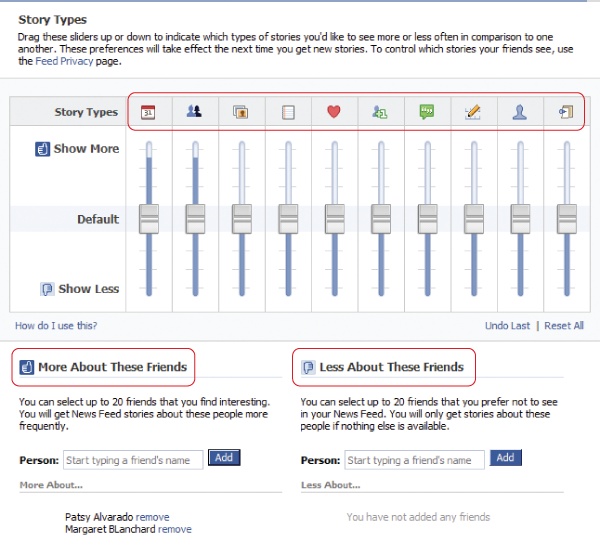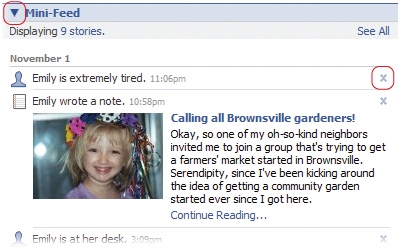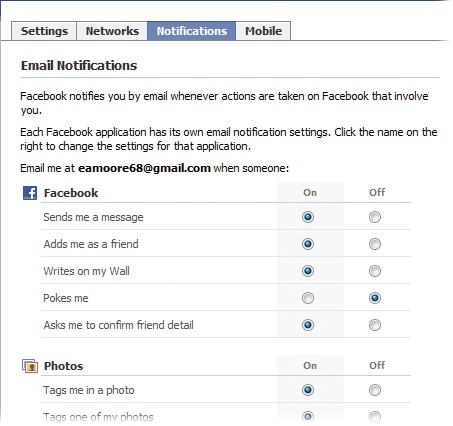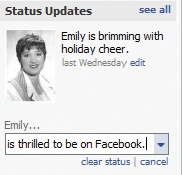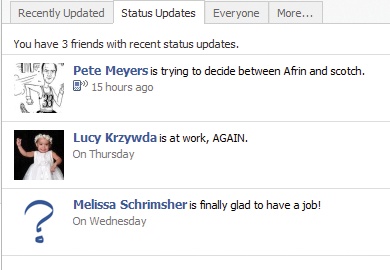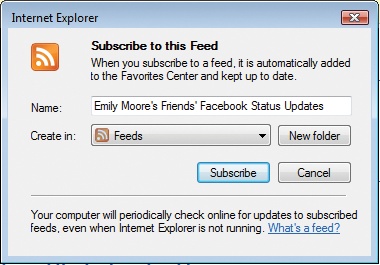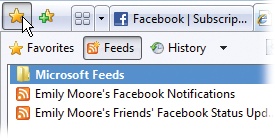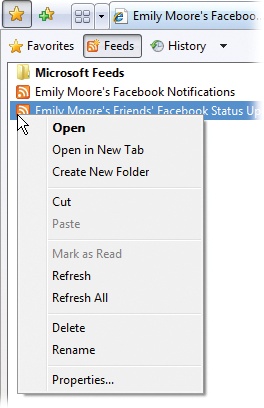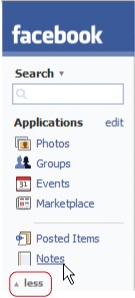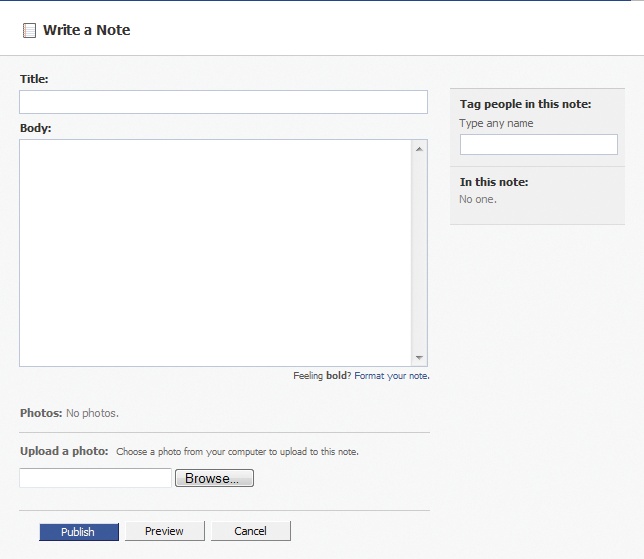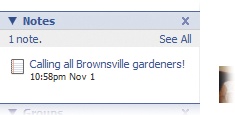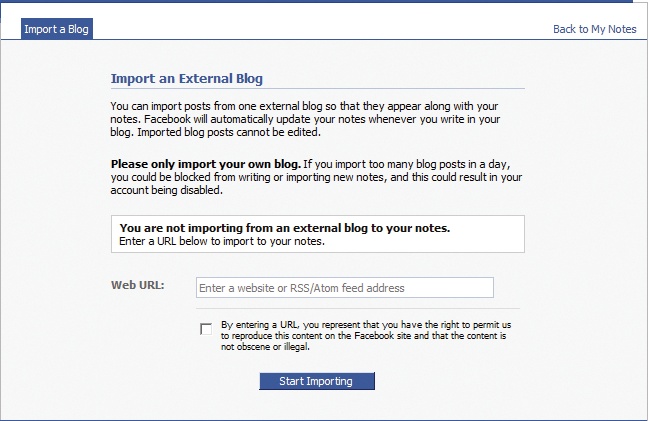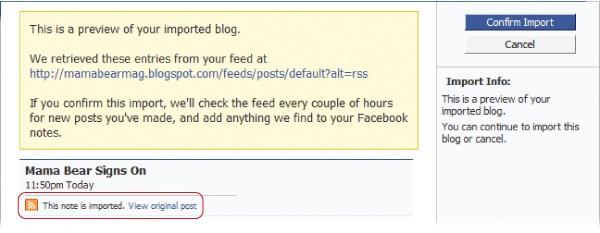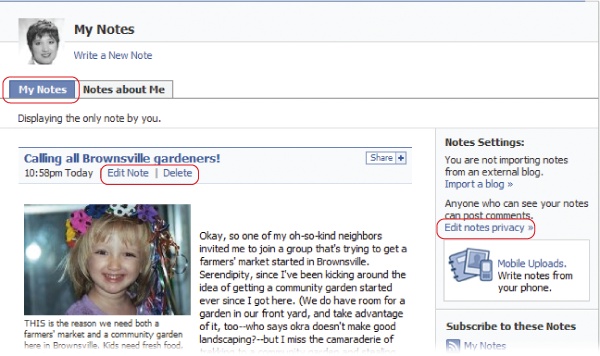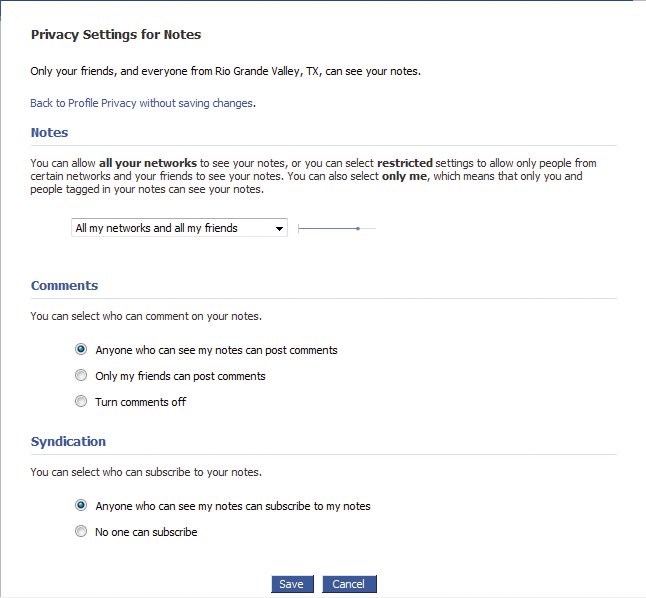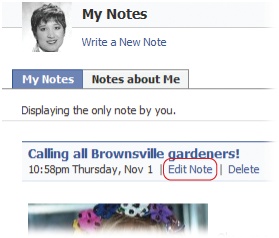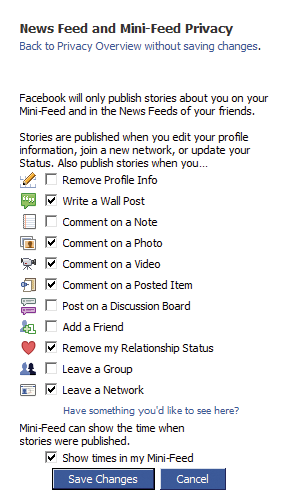Chapter 5. Exchanging Automatic Updates
Remember what keeping up with your friends used to require? Time-consuming emails (Sorry it’s been so long...), potentially intrusive instant messages (hello? u there?), even the occasional in-person visit. No more. Thanks to Facebook’s easy-to-activate broadcast and subscription tools, staying in touch is easier than ever. Subscriptions and notifications, for example, alert you when, say, your best friend uploads a new picture, your softball coach gets off work, or your study buddy posts his analysis of Macbeth. This chapter shows you how to sign up for and tweak these handy updates.
Types of Updates
Facebook offers four different ways you can get details about your friends’ activities. Three (news feeds, mini-feeds, and notifications) appear automatically—on your home page, your profile, and your notification inbox, respectively.
Note
Although the news feed, mini-feed, and notifications are all hard-wired into your account, Facebook lets you customize the details you see in all three. Read on for details.
If you prefer to keep up with your pals without having to log in to Facebook, you can choose to sign up for customized Web feeds called subscriptions
Note
Facebook offers one other kind of automatic update: It tells you when friends’ birthdays are coming up. If you check the Birthdays section of your home page (it’s on the right-hand side) every time you sign on, you’ll never again forget a friend’s birthday.
News Feeds: What Others Are Doing
News feeds are constantly updated lists of the things your Facebook friends are doing on the site: adding applications, writing on walls, commenting on notes and photos, and so on. Your news feed appears automatically on your Facebook home page, front and center—you don’t need to do anything special to see it. Facebook doesn’t let you do away with your news feed, but you can customize it to show more (or less) of the activities—and the friends—you’re interested in.
Customizing Your News Feed
In every social circle, you’re bound to have some friends you’re closer to than others. If you’d prefer to concentrate on just two or three friends’ activities—or skip the who’s-dating-who-this-week chatter and focus just on the groups or events your friends are involved with—you can do so by customizing your news feed. Here’s how:
From your home page, head to the News Feed section and click the Preferences link.
On the page that appears, tell Facebook what you want to see more of on your news feed, and what you want to see less of. Drag the sliders up to see more event-related news, group-related news, and so on, and drag them down to see less.
Tip
Mouse over each Story Types icon to see a quickie highlighted description of each news category you can customize using its slider.
To see more news about certain friends, head to the More About These Friends section in the lower-left part of the page; type in a friend’s name, and then click Add. To see less about certain friends, do the same in the lower-right Less About These Friends section. After you make each change, Facebook pops up a temporary Saved Setting message (or Restored Setting message, if you clicked Undo Last).
Note
News feeds work both ways: Facebook keeps track of your actions on the site, too, and includes them in your friends’ news feeds. To learn how to prevent certain things you do from showing up on your friends’ news feeds, see Preventing People from Subscribing to Your Status Updates.
Mini-feeds: What You’re Doing
Your news feed keeps track of all the stuff your friends do on Facebook. Similarly, your mini-feed (which appears on your profile page) chronicles the stuff you do on Facebook. Anyone who can see your profile can see your mini-feed.
Note
The mini-feed doesn’t contain additional information; it just aggregates the juicy bits displayed elsewhere on your profile. So, what people can’t see on your profile, they can’t see on your mini-feed. For example, if you RSVP to a secret event and your friend Ralph wasn’t invited, he won’t be able to find out he was snubbed by reading your mini-feed.
Customizing Your Mini-feed
You can customize the mini-feed that appears on your profile in two ways:
By removing individual stories. Stories are specific actions you’ve taken on Facebook, such as updating your status (Subscriptions) to “Heading home for the day.”
By telling Facebook to leave out categories of actions. You can tell Facebook to keep mum when you comment on a note or leave a group, for example.
To customize your mini-feed:
On the Facebook main menu, click Profile.
Scroll down to the Mini-Feed section of your profile and read through the stories. If you don’t see any stories listed beneath the Mini-Feed heading, click the right-arrow to expand the section.
Delete any stories you don’t want people to see. Click the X at the right end of a story snippet (and then, in the confirmation box that appears, click the Hide Story button) to delete that story from your mini-feed.
Specify which types of actions you want to reveal in your mini-feed, and which you don’t. See Preventing People from Subscribing to Your Status Updates for details.
Facebook Notifications
A notification is a message telling you that something involving you happened on Facebook: Someone wrote on your wall, for example, or invited you to join a group, or replied to something you said on a discussion board.
Note
Notifications and news feed items are so similar it’s easy to get them confused. Both are juicy, gossipy electronic paper trails of your friends’ activities on Facebook. The difference? notifications somehow involve you: Someone wants to join a group that you administer, someone tagged you in a note (Tagging Notes), and so on. news feed items, on the other hand, don’t involve you directly. news feeds simply let you know what your friends are up to: that one friend installed a new application, say, and another one updated her profile picture.
Viewing Your Notifications
Notifications appear in two places: in your regular email program’s inbox, and on Facebook’s Notifications tab. You also get a heads-up on your home page when you get a notification.
Note
Subscribing to your notifications lets you see them as a Web feed (Subscriptions) instead of on your Facebook Notifications tab.
To see the email versions of your notifications, head to your email program and view your emails just as you normally would.
To see your notifications in Facebook, at the top of any Facebook screen, click the down arrow next to Inbox, and then choose Notifications from the drop-down menu. Make sure the Notifications tab is selected; if it’s not, click it to select it. The little blue dot that appears in front of some notifications means that they’re new. (The dot and the corresponding heads-up on your home page disappear after you display the Notifications tab.)
Choosing Which Notifications You Want to See
Unless you tell it otherwise, Facebook assumes you want to be notified about a staggering amount of social minutia. This means that if you have more than two or three friends who actively use the site, your email inbox will overflow from all the notifications you’ll receive.
To specify what you want to be notified about and what you don’t, follow these steps:
On the Facebook main menu, click “account”.
On the page that appears, click the Notifications tab.
On the Email Notifications tab, turn on the Off radio box next to any activity you don’t want to hear about, and then scroll down to the bottom of the page and click Save Changes.
Tip
Facebook always displays friend requests, invitations to groups and events, and photo tag requests (Tagging (Labeling) Your Pictures) on your home page, so the notifications you get about these activities are redundant. Turn them off and you won’t miss a thing (assuming you check your home page from time to time).
Subscriptions
Technically, subscriptions are Web feeds—those ubiquitous summary blurbs provided by Web publishers like the New York Times and Reuters and known to geeks everywhere as RSS, which stands for Rich Site Summary or Really Simple Syndication depending on who you ask. Whatever you call them, think of a subscription as a continuously updated newsletter that’s stored as a big chunk of data that you can format and view however you like—as a basic, no-frills list of items on a Web page, for example, or in a fancy online news reader.
Note
When you follow the steps in Subscribing to Friends’ Status Updates, your subscription appears as a basic list on a Web page. To see it in a different format, check out one of the many free news reader (a.k.a. aggregator) programs and services, such as Bloglines(www.bloglines.com), Google Reader (www.google.com/reader), or Feed Demon (www.newsgator.com). For an in-depth look at all things Web feed, check out http://oreilly.com/feeds.
Subscriptions don’t give you any info that you couldn’t find by combing through Facebook, but they make that information easier to get to because it appears on a single Web page that updates automatically. Plus, you don’t have to log in to Facebook to see it. And, depending on which Web browser you use, you can customize the way you see subscription info. For example, if you use Internet Explorer, you can sort subscription info, specify how often you want to see updates, and even play a sound when the info gets updated.
You can sign up for one or more of the following subscriptions:
A subscription that shows the current status of your friends. A Face book status is a quick one-liner that your friends type in from time to time, such as “I’m leaving work” or “I’m at the library.” Signing up for a status subscription lets you track where your friends are and what they’re doing at any given time without having to log in to Facebook.
Note
To update your status: On your home page (get there by clicking the “home” link at the top of any Facebook screen), scroll to the Status Updates section and click the “What are you doing right now?” link. (If this isn’t the first time you’ve updated your status, you’ll see an “edit” link instead).
Type whatever you’d like in the box that appears (you can delete the word “is” if you want to use a different verb), or click the down arrow and choose something from the list (like “is at home” or “is at work”). When you’re done, simply click somewhere else on your screen and Facebook updates your status so all your friends can see what you’re up to. Click the “clear status” link to erase what you wrote in the box.
A subscription that shows you the stuff—Web links, photos, video links, and so on—your friends are posting, as they post it. Because this kind of subscription gives you a one-stop shop for all the resources your friends are sharing, it’s perfect for work and study groups.
Note
To see how to post your own stuff, check out Creating a Page.
A subscription that shows you the notes your friends (or other Facebook members) are publishing, as they publish them. (Flip to Creating Notes (Blogs) to learn about Facebook notes.) Signing up for a notes subscription helps make sure you don’t miss a single exciting installment of your friends’ blogs (er, Facebook notes—see Creating Notes (Blogs)), even when you’re not logged in to Facebook. You can subscribe to notes published by any Facebook member who chooses to syndicate her notes (make them publicly available for subscription), even if you’re not friends with her.
Tip
Subscribing to your own notes sounds weird, but it’s useful if you want to package your notes for cutting and pasting to another blog service (see Creating Notes (Blogs)).
A subscription that shows you all your notifications. Unless you tell it differently, Facebook assumes you want to see your notifications (Choosing Which Notifications You Want to See) in the Notifications tab and in your email inbox. But if you prefer, you can choose to view them in subscription form—handy if you want to keep in touch with your Facebook pals without having to log in to the site or comb through a mountain of emails.
Subscribing to Friends’ Status Updates
At the top of any Facebook screen, click the down arrow next to Friends, and then choose Status Updates. The Status Updates tab appears, listing the current status of all your friends.
Head to the right side of the Status Updates tab and click the Friends’ Status Feed link.
Follow the steps in Subscribing to Your Notifications.
Subscribing to Friends’ Posts
You can sign up for one subscription that shows you all the stuff all your friends post—Web sites, video clips, and so on—or one subscription for each of the friends you’re interested in. Here’s how:
In the Applications menu on the left side of your screen, click Posted Items (you may have to click “more” to see the Posted Items link).
On the Posted Items page that appears, head to the “Show recently posted items by” drop-down box and choose either All Friends or the name of one of your friends.
Head to the right side of the Posted Items page and click either My Friends’ Posted Items (if you chose All Friends in step 2) or a link similar to “Stan Dupp’s Posted Items” (if you chose a specific friend in step 2).
Follow the steps in Subscribing to Your Notifications.
Subscribing to People’s Notes
Creating Notes (Blogs) tells you all about notes (Facebook’s version of blogs). To subscribe to someone’s notes:
In the Applications menu on the left side of your screen, click Notes (you may have to click “more” to see the Notes link).
On the Notes page that appears, click the My Friends’ Notes link.
Tip
To subscribe to an individual’s notes, whether or not that person is your friend, surf to her profile (Finding Friends), and then scroll down to the Notes section and click See All. Then, on the person’s Notes page, click the “Eileen Doe’s Notes” link (or whatever the person’s name is).
Follow the steps in Subscribing to Your Notifications.
Subscribing to Your Notifications
Finalizing Your Subscription
No matter what kind of subscription you’re signing up for, the following steps apply. (Do them after you’ve finished the steps for the particular feed you’re subscribing to.)
In the page that appears, click “Subscribe to this feed” (or the similarly worded link that appears in your browser).
In the box that appears, choose the bookmark folder you want to put your subscription in. The feed name Facebook suggests is perfectly workable, if a little boring, so don’t feel you have to type in a new one (although you can if you want). Because you access subscriptions through your Web browser, the folder you choose from the “Create in” drop-down list (or create using the “New folder” button) appears in your Web browser’s feeds list.
Note
Bookmarking a Web page makes it easy for you to return to that page again later. You see the name of your subscription’s bookmark folder when you view your Web browser’s feeds list. (Every browser is different. To see your feeds list on Internet Explorer, click the Favorites Center button—the tiny yellow star at the left of the main menu).
Click Subscribe. Up pops a message telling you your subscription was successful. To see your subscription, you can either click the “View my feeds” link on the success message, or use your browser’s menu to see all your listed feeds. If you use Internet Explorer, for example, click the Favorites Center icon (the little star on the left side of the menu) to view your feeds.
Note
If you’re not thrilled with the way your Web browser displays your subscriptions (a.k.a. feeds), you can use a free news aggregator service such as www.Bloglines.com to display them instead. You need a feed’s URL to view it using an aggregator. If you’re using Internet Explorer as your Web browser, try right-clicking your feed listing, and then choosing Properties to see the feed’s copy-and-paste-able URL.
Creating Notes (Blogs)
Ever since “blogosphere” replaced the more mundane “bunch o’ personal Web sites,” every site worth its salt offers free blogs—easy-to-use online journals where you chronicle your hobbies, family or work life, or whatever you feel like writing about. Facebook offers free blogs, too—it just calls them notes instead.
Note
There’s a slight—but very important—difference between notes and regular old blogs: Because Facebook integrates notes with all the other stuff you do on the site (thanks to tagging), notes can actually document the complex social interactions between you and your friends (and your friends and their friends, and so on). It’s scary, it’s exciting, it’s très 21st-century—and it’s a marketer’s dream come true.
You can either upload an existing blog (if you have one) into notes, or you can create your own notes from scratch. And here’s the cool part: You can tag your notes. Tagging a note means associating one or more of your Face book friends’ names with the note. For example, say you write a note describing the fishing trip you and your pal Fred took together. You can tag the note with Fred’s name, making it easy for Fred—and his Facebook friends—to locate your tale of the trip.
After you create a note, Facebook lists the note’s subject line on your profile page (look for the Notes section) so other folks can find your note and comment on it. At the same time, the site automatically sends notifications to all the friends you tagged so they can check out what you said about them.
Note
By tweaking your Notes privacy settings (which you access by clicking the “Edit notes privacy” link shown in Viewing and Changing Your Notes), you can control who gets to know about, see, and comment on your notes. Flip to Restricting Access to Your Notes for step-by-step details.
Typing Notes from Scratch
If you don’t already have a blog, or you do have a blog but you don’t want to cut and paste it into Facebook, you need to start fresh. To create your first blog installment on Facebook:
From the Applications menu on the left side of any Facebook screen, choose Notes.
Note
If you don’t see Notes in the Applications menu, expand the menu by scrolling to the bottom of it and clicking the “more” link.
On the Notes page that appears, click " Write a New Note”. On the “Write a Note” page, fill in the Title field with a subject line for your note (think of it as a summary of your entry and shoot for provocative, concise, or both). In the Body field, type your note.
If you like, add a photo or two. To do so, click the Browse button and, in the window that appears, select the image file you want to add. Repeat this process to add additional photos.
If you want to, tag the note. Tagging is a way of associating the note with a Facebook friend (or two). If your note chronicles the office Christmas party, say, you might want to tag the office mates you mention. To tag your note, click the “Tag people in this note” field and start typing; then choose one of the names Facebook helpfully displays.
Note
For a blow-by-blow on tagging, see Tagging Notes.
Click Preview to give your note a quick once-over. Double-check what you’ve written and check the formatting, which can get a little funky (especially if you added photos). If you see something you don’t like, click Edit to change your note. Then repeat the Preview-Edit cycle until you’re happy with the result.
Tip
Facebook uses HTML (hypertext markup language) to format notes. If you know HTML, use it: Type HTML tags directly into the Body field along with your text. To see a quick-and-dirty HTML cheatsheet, click the “Format your note” link just below the Body field. To learn more about HTML, check out Creating Web Sites: The Missing Manual.
Click Publish. Facebook lists your new note in the Notes section of your profile for all the world (technically, all your friends and fellow network members) to see and comment on, and sends notifications to the folks you tagged.
Note
After you publish your note, you can share it with people who aren’t yet on Facebook. To do so: From the My Notes page (see Viewing and Changing Your Notes), head to the title of the note you want to share and click the Share button.
Importing Notes from an Existing Blog
If you’ve already got a blog on some other site (such as www.Typepad.com or www.Blogger.com), you can tell Facebook to duplicate your blog entries as Facebook notes. That way, the people on Facebook can read your musings without your having to type every blog entry twice.
Note
You can’t use Facebook to edit the notes you import from some other blogging site. Instead, you have to edit your notes using the other blogging service’s Web site, just as you do now. Think of Facebook’s version as a reprint.
To import blog entries from an existing blog into Facebook:
From the Applications menu on the left side of your screen, choose Notes. You may have to click “more” to see the Notes link.
On the Notes page that appears, click My Notes, and then click “Import a blog” on the right side of the page.
On the “Import a Blog” page, head to the Web URL field and type in your blog’s URL (for example,http://YourNameHere.blogspot.com). Turn on the checkbox to reassure Facebook that the blog you’re importing is yours (it needs to be; adding anything to your Facebook account that you personally haven’t created or bought rights to distribute spells copyright infringement), and then click Start Importing.
In the confirmation page that appears, click Confirm Import. Facebook adds the imported blog entries to your from-scratch notes with one difference: a tiny orange icon that lets people know the entries have been imported from somewhere else. If folks click the “View original post” link, they’ll jump to the blog the entry came from.
Viewing and Changing Your Notes
Facebook makes it easy to see all the notes you’ve written and change or delete them, one at a time. To see and edit your notes:
Note
If you import notes, you can’t change them in Facebook. You can, however, see and delete them by following the steps below.
From the Applications menu, choose Notes. You may have to click “more” to see the Notes link.
On the Notes page that appears, click the My Notes link in the upper left. If you don’t see the full text of your notes, click the My Notes tab.
To edit your note, head to the note’s title line and click Edit Note.
To delete your note, click Delete.
Restricting Access to Your Notes
Unless you tell Facebook otherwise, all your Facebook friends and fellow network members can see, subscribe to, and comment on the notes you write. But you can customize access to your notes so that:
All Facebook members can see your notes.
Only the people in certain networks (such as your work network or your school network) can see them.
Only your friends can see them.
Only the people you’ve tagged in your notes can see them.
Only your friends can comment on your notes.
Nobody can comment on your notes.
Nobody can subscribe to your notes.
Note
For the scoop on subscriptions, see Subscriptions.
To modify access to your notes:
From the Applications menu, choose Notes. As always, you may have to click “more” to see the Notes link.
On the Notes page that appears, click My Notes in the upper left. Then, on the My Notes tab that appears, head to the right side of the page and click “Edit notes privacy”.
Change who can access or add public comments to your notes. From the drop-down list in the Notes section, choose the option that best describes who you want to be able to read your notes. Then head to the Comments section and tell Facebook who you want to let comment on your notes (see the next section of this book). Finally, to prevent people from subscribing to your notes, scroll down to the Syndication section and turn on the “No one can subscribe” radio button. When you finish making changes, click Save.
Adding Comments to Notes
Every time Facebook displays a note that you (or anyone else) has created, it also displays a link people can use to comment publicly on that note.
Note
If you don’t want people commenting on your notes, you can tell Facebook to remove the “Add a comment” link from your notes—see Restricting Access to Your Notes.
Comments give the people who read your notes an easy way to stroke your ego, give you advice, or post helpful resources. And because the comments people leave appear one after the other, right after the text of your note, they’re easy to see and to change. On a notes page, you can:
Add a comment to someone else’s note. However you stumble across someone else’s note—by viewing your friends’ notes (from the Applications menu, choose Notes), surfing to the Notes section of a fellow network member’s profile (Viewing the Networks You’re Already On), or perusing Popular Notes (from the Applications menu, choose Notes, and then click the Popular Notes link)—the way you add a comment is the same: Simply click the “Add a comment” link at the bottom of the note. (If you don’t see this link, it’s because the note writer told Facebook to remove it—see Restricting Access to Your Notes.)
Note
Unless you tell it otherwise, Facebook automatically notifies you when someone comments on one of your notes. (Choosing Which Notifications You Want to See tells you how to change this behavior.)
View the comments other people have added to your note. From the Applications menu, choose Notes and then click the My Notes link. Then scroll down to the bottom of your note to see all the comments people have left for you.
Delete a comment someone has added to your note. Perhaps someone added an offensive comment, or just one you’d prefer your friends not to see. Head to the bottom of the comment and click Delete; then, in the confirmation box that appears, click Delete again.
Note
If someone leaves an inappropriate comment—and overzealous marketing people, among others, have been known to do just that—you can send him a “cease and desist” message by clicking the Message link at the bottom of the comment. If that doesn’t do the trick, you can block that person from seeing your notes (Fighting Back) or report him to Facebook (Reporting Violations).
Tagging Notes
Tagging a note links the note to one or more of your friends, whether or not the person’s actually mentioned in the body of the note. It’s a win-win situation: Your friends get warm fuzzies from being tagged (everybody likes to feel important), you get more folks reading your notes, and the companies that advertise on Facebook get a more complete picture of your social network.
You can tag a note while you’re creating it—as explained Typing Notes from Scratch—but you can also tag a note after you’ve published it. To do so:
From the Applications menu, choose Notes. You may have to click “more” to see the Notes link.
On the Notes page that appears, click My Notes. Make sure the My Notes tab is selected.
Scroll down to just below the note’s title and click the Edit Note link.
In the “Tag people in this note” field, start typing the name of the friend you want to tag. Facebook pops up names as you type; click to select one. You can tag as many of your friends as you like.
Scroll down to the bottom of the page and click Save.
Finding Mentions of Yourself in People’s Notes
Just as you can tag notes with your friends’ names, they can tag their notes with yours. To see a list of all your friends’ notes that mention you:
From the Applications menu, choose Notes. You may have to click “more” to see the Notes link.
On the Notes page that appears, click “Notes about You.” All the notes your friends have tagged with your name appear.
Note
You would never write a note describing a scene of wild debauchery and then tag a squeaky-clean, trying-to-land-an-important-job friend (thus ruining any chance she has of passing her pre-interview background check). But some people would. Fortunately, Facebook lets you delete tags, even if someone else added them. On the Notes About Me tab, scroll down to the note you want to disassociate yourself from and click the “remove tag” link that appears just under your name.
Controlling What People See About You
As part of its mission to provide as much customizable privacy as possible, Facebook lets you prevent people from subscribing to your notes and to your status updates. You can also remove certain details about your actions from your mini-feed and from the news feeds your friends receive.
Preventing People from Subscribing to Your Notes
If you don’t want to let anyone subscribe to your notes (Subscribing to People’s Notes), follow these steps:
In the Applications menu on the right side of your screen, click Notes (you may have to click “more” to see the Notes link).
On the right-hand side of the Notes page that appears, under the Notes Settings heading, click the “Edit notes privacy” link.
On the Privacy Settings for Notes page, head down to the Syndication section and turn on the “No one can subscribe” radio button.
Preventing People from Subscribing to Your Status Updates
If you don’t want people to instantly know when you change your status from “Hard at work” to “Counting the seconds till quittin’ time,” here’s what you do:
On the Facebook main menu, click “privacy”; then, from the Privacy Overview page that appears, choose Profile.
On the “Privacy Settings for your Profile” page, turn off the checkbox next to “Allow friends to subscribe to my status updates”.
Removing Details from Your Mini-feed
Here’s how to tell Facebook which of your activities it can automatically tell your friends about via their news feeds or your mini-feed—and which it can’t:

